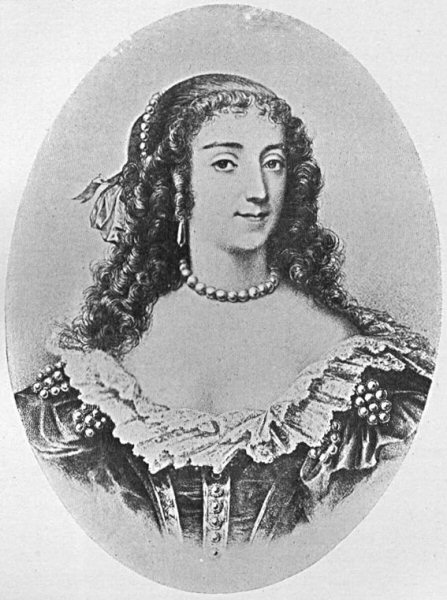- Marie de Rohan-Montbazon, duchesse de Chevreuse
Infobox Person
name = Marie de Rohan-Montbazon
Duchesse de Chevreuse

image_size = 200px
caption = The duchesse de Chevreuse
birth_date = 1600
birth_place =
death_date =August 12 1679
death_place =Gagny ,Paris
occupation =Courtier
nationality =
spouse = 1 Charles d'Albert, duc de Luynes; 2 Claude de Lorraine, duc de Chevreuse.
parents = Hercule de Rohan, duc de Montbazon
children = 1 Louis-Charles d'Albert; 2 Anne-Marie de Lorraine; 3 Henriette de Lorraine; 4 Charlotte-Marie de Lorraine.Marie Aimée de Rohan-Montbazon, duchesse de Chevreuse (1600 –
August 12 1679 ) was a French aristocrat of great personal charm who placed herself at the center of all theintrigues of the first half of the 17th century in France.Early life
Marie de Rohan, styled "Mlle de Montbazon", was the daughter of
Hercule de Rohan, duc de Montbazon of theHouse of Rohan , possessed of great estates in Brittany and Anjou. In September 1617 she married the Grand Constable (supreme commander of the French armies) Charles d'Albert, duc de Luynes, afavourite of Louis XIII; he formed her taste for unscrupulous political intrigue, introducing her at court, where she gained the confidence of both king and queen. In December 1618, Louis XIII named her "surintendante" of the Queen's household, ousting the connétable de Montmorency. Her influence with thequeen consort Anne of Austria was unrivaled. In 1620 she gave birth to Louis-Charles d'Albert, for whom Louis XIII stood godfather.econd marriage
After Luynes died in combat in 1621, she married Claude de Lorraine, Duc de Chevreuse on April 21 1622. From this second marriage she had three daughters. Two of them were religious, Anne-Marie de Lorraine (1625–1652), abbess of Pont-aux-Dames, and Henriette de Lorraine (1631–1693), abbess of Jouarre and later at
Port-Royal . The third daughter, Charlotte-Marie de Lorraine (1627–1652), having failed to wed Armand de Bourbon, Prince de Conti, became the mistress ofCardinal de Retz and played a role in theFronde , never having married.Fall from favor, conspiracies
Friend and confidante of the Queen, she was banished from Court after an incident in which she had encouraged the pregnant queen in boisterous games in the corridors of the Louvre, resulting in a mishap and the abortion of the child. The duc de Chevreuse used all his influence to have her reintegrated at Court.
In her attempts at regaining her lost position, she provoked or encouraged the conspiracies of the court, such as the Buckingham affair (1623-24) that compromised the Queen, which she instigated with the connivance of her English lover, Henry Rich, later created Earl of Holland, and of the highest-ranking aristocrats against Richelieu, such as her complicity in the conspiracy of her lover, the comte de Chalais, that she set up in 1626, with the unlikely intention of replacing Louis XIII with his brother,
Gaston d'Orléans , for which Chalais, deeply embroiled, lost his head, 19 August 1626, while the duchesse de Chevreuse fled to Lorraine, where she soon carried on an affair withCharles IV, Duke of Lorraine , who intervened on her behalf to allow her back in France; once she was reestablished atDampierre , her subversion of royal power continued. She was at the center of all the intrigues that involved foreign powers against France: negotiations with theduchy of Lorraine and withSpain conducted byCharles de l'Aubespine, marquis de Châteauneuf , keeper of the seals, who ruined himself on her behalf, revealing to her the councils of the king (1633). Secret exchanges of correspondence with Spain carried out by Anne of Austria were unmasked in 1637, requiring Mme de Chevreuse to flee to Spain, then to England and finally to Flanders. She was involved in the conspiracy of the comte de Soissons (1641) and at the death of the king, a clause in the testament of succession forbade the return to France of the Duchess: a decision of theparlement of Paris was required to break the will.After the death of Richelieu, once again in France, she conspired at the center of the "cabale des Importants" led by Chateauneuf against
Mazarin , in 1643; with the arrest and exile ofCésar de Bourbon, duc de Vendôme she too fled once again. During theFronde , she came closer to Mazarin for a time (1649–1650), but then she switched back to the aristocratic party when the parliamentary Fronde and the aristocratic Fronde joined forces in 1651.She died in retirement in the convent of
Gagny (Seine-Saint-Denis "département ") in 1679.Biographies
She was a tempting subject for colorful biography in the Romantic era:
Alexandre Dumas, père entangles her in the plots of "The Three Musketeers " and "Twenty Years After ", in which Raoul, the hero of the third novel of Dumas' trilogy, is the secret son of La Chevreuse and the musketeer Athos.Gaetano Donizetti 's tragic opera "Maria di Rohan ", which debuted at theKärntnertor theater, Vienna, 5 June 1843, followed by a success in Paris in November, was freely based on the conspiracy of Chalais.Victor Cousin published a more serious biography in 1856 Modern biographies are by Denis Tillinac ("L'Ange du désordre", (Paris: Robert Laffont) 1985, by Christian Bouyer, "La Duchesse de Chevreuse : L'Indomptable et voluptueuse adversaire de Louis XIII" (Paris: Pygmalion-Gérard Watelet) 2002, and by Georges Poisson (Paris:Librairie Académique Perrin) 1999. The most recent biography in English is H. Noel Williams, "A Fair Conspirator: Marie de Rohan, Duchesse de Chevreuse" 2005.In 2002, she was portrayed by
Wendy Albiston in the "Doctor Who " audio drama "The Church and the Crown ".External links
* [http://www.ville-gagny.fr/Ville_Histoire4.asp?IdPatrimoine=705 (Ville de Gagny) Eric Guichard, Archiviste de la Société Historique du Raincy et du Pays d'Aulnoye, "Maria di Rohan, duchesse de Chevreuse"]
Wikimedia Foundation. 2010.
